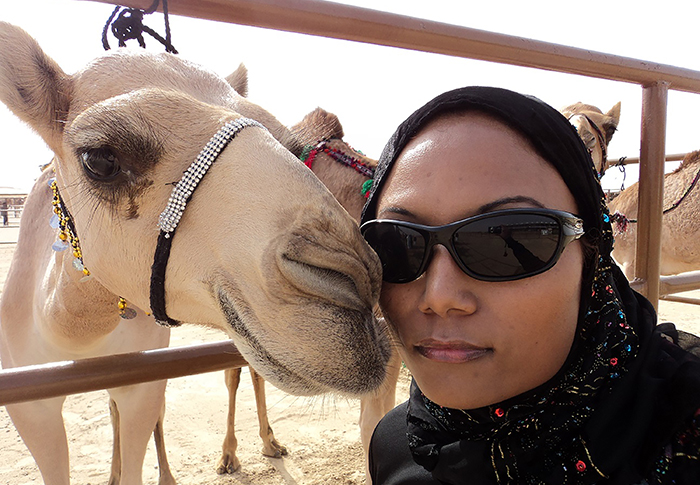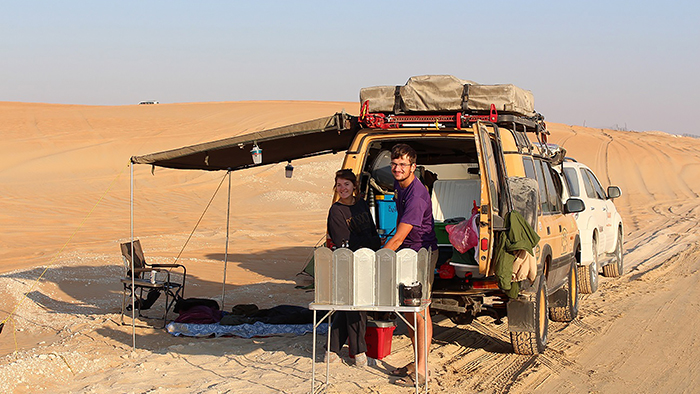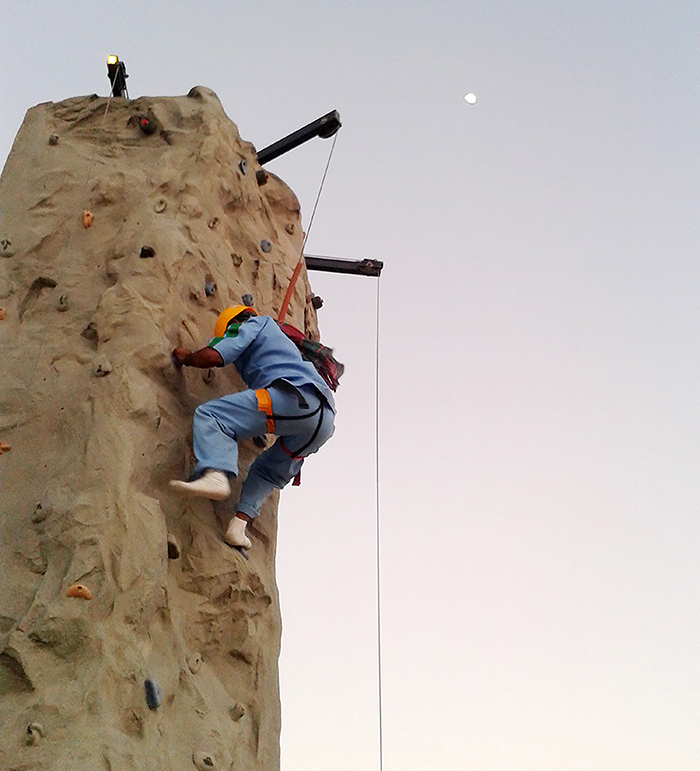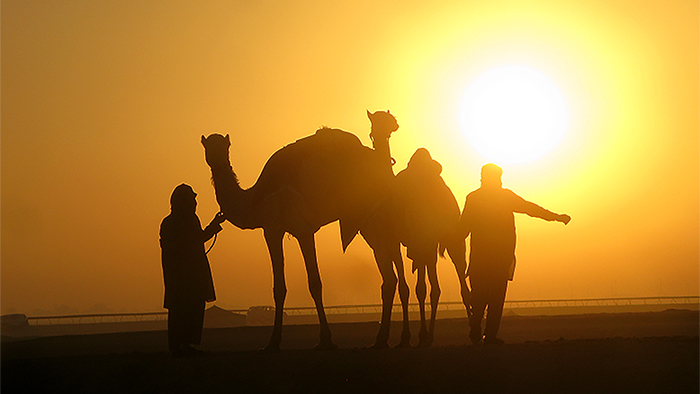Dhafra in the Al Gharbia area of the western region is the premier camel festival in the GCC and famous for its internationally acclaimed “Beautiful Camel Competition.” It runs from the 10th to the 31st December annually.
Located just 10kms outside Madinat Zayed City and around 60km away from the Liwa sand dunes on the Saudi border, the Dhafra festival is based beside the Camel Race Track there and boasts a huge range of attractions for visitors and for local breeders to compete their camels, dogs, sheep, falcons and dates in.
The Camel events consist of:
- Beautiful Camel Competition
- Camel Milking Competition
- Camel Racing
- Camel auctions (held on “The Million Road”)

Other events include:
- Saluki dog racing
- Purebred Arabian horse race
- Falcon speed trials
- Sheep Beauty Pageant
- Sour Milk Competition
- Children’s Talent Competition
- Best Photography Competition
- Best Dates
- Best Date Packaging
- Best Handicrafts Competition
- Classic Cars Competition
- Artists Workshops
- Traditional Handicrafts Workshops
The event is covered by its own TV network which has a central TV station on site and roving camera and interview units. It is also covered by local news networks around the GCC, especially for the finals of each competition.
“The Million Road” is aptly named as it is here that the deals go down for buying and selling camels and it is a common occurrence for the best breed lines to sell for a million dirhams or more. These auctions are worth the trip out to the festival on their own and form a central part of the heritage of Khaleeji camel farming. The owner will display the camel for sale (often with a baby alongside) by parading it down the road (which is not tarmacked) and tooting their horns and playing loud music to attract potential buyers’ attention. When someone who is interested approaches they will be with friends and all the cars will encircle the camel and corral it in the middle. The buyers then jump out and form up as a Yola dance line with the cane sticks and the sellers will form up opposite them. Then commences the barter in which each side will sing out their offer or counter offer and dance with their family members in the line. When a price is agreed, the reins exchange hands ceremonially (the cash will change hands later) and the buyer will then parade their prize back to their camp with much tooting of horns, backfiring of exhausts and general happy and celebratory behavior. It’s not unusual to see people dancing on the roof or bonnet of speeding Land Cruisers and it’s amazing how agile the dancers are since the roads are so rough!

In stark contrast to the loud auctions, the falcon speed tests are quietly conducted and the onlookers recline in beautiful chairs with binoculars at the ready to watch their prized falcons compete. A handler will take the falcon to the start position and a caller will spin a lure in the air several hundred meters away and call for the falcon. The falcons’ flight is recorded along the flat and recorded at its fastest point. Often immature birds will be distracted and fly off at right angles or go straight up or just not see the lure and fly away from it, this is why the competition requires so much quiet from the watchers to not distract the birds.
The saluki racing is much the same as greyhound racing in the west and the camel racing is a hugely popular event because instead of robotic jockeys they have real people and this causes much hilarity in the audience although they also take the whole thing very seriously. The age categories are based on the riders and you will see everyone from teenaged boys to men over 80 taking part. The older riders often wear cricket pads, life jackets, skateboard pads and cycle helmets to protect themselves if they fall off (Camels are pretty high to fall from!). It’s not unusual to see a camel finish the race alone and it’s jockey come running in several hundred meters behind it! The camel races are accompanied by a vast herd of cars in a dust storm that races down the road alongside the track so the trainers and owners can shout encouragement to the camels in voices they recognize and respond to.
One of the nicest aspects of the Dhafra festivals is that it is so focused on the locals and traditional cultural pursuits but they in turn make tourists so welcome. Every family taking part has a tented camp around the camel track and there is only one hotel in the area – the Tilal Liwa, which is fully booked months in advance so it is very common for locals to walk up to tourists and invite them back to their camps for meals, dancing and even to stay the night. This is a culture where the guest is treated like royalty and it is at an event like this that you really get to experience that.

The festival is full of small tented stalls with everything from camel harnesses to 4×4 overland kits and the area is a 4×4 driver’s paradise with many trails across the sands and anytime you get stuck countless friendly people to assist pushing and pulling you out of the sand! (I got stuck and was rescued by six friendly Pakistani camel herders who refused a tip and instead enjoyed a cold bottle of water each from my icebox!).
You will have ample opportunity to try out your Arabic and you will also be inundated with small children keen to try out their one or two English phrases from school. The event is a melting pot of everyone from the region’s camel trade and you will meet Saudis and Sudanese and Omanis and Bahrainis and Qataris and Syrians and many, many more. In one day I managed to use my few phrases of Arabic, Urdu and French which ended in a pigeon language that must have sounded familiar but nobody quite understood!

Al Dhafra also boasts its own complete adventure camp as part of the VEDC Heritage Camps, which this year was run by ADAPT, the outdoor education camp based out of Ras Al Khaimah. The camp runs adventure activities in three day blocks for upwards of 500 students at a time and this facility is provided to schools in the UAE for free! Every student is taken on trips around the cultural aspects of the festival as well as having the chance to take part in fun activities like the: Challenge course, climbing wall, SUP boards, inflatable assault course, archery, Bedouin survival and many more fun and challenging events.
If you do decide to head there in 2016 then make sure you pack for a long trip! It takes a good three hours from Abu Dhabi and for me from Ras Al Khaimah it took six hours in my 1996 Land Rover which is rather aptly a Camel Trophy Edition! The camp has many facilities including public toilets, launderettes in a tented village and even a Costa Coffee and several small food shops and lots of traditional food restaurants. You can camp pretty much anywhere and the police are more than helpful if you stop and ask them where to go. You can get additional information on event timings and locations from the administration tent beside the heritage village and from the website at www.aldhafrafestival.ae
Don’t forget if you get stuck in the sand you’re never far from a team of rescuers who are only too happy to help!
Words By: Dan Wright

